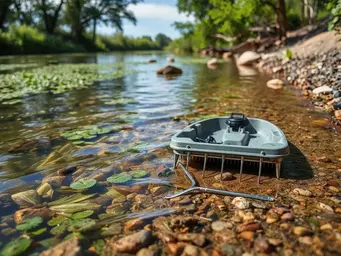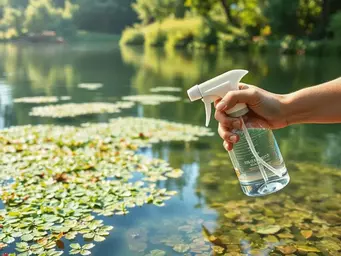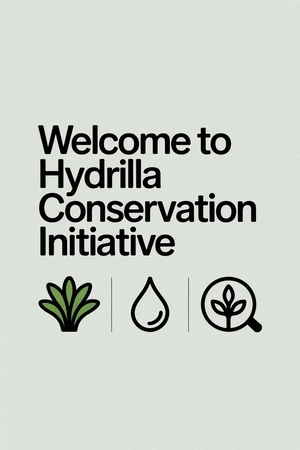Are you aware of the critical role that regulations play in managing invasive aquatic species? As we delve into the evolving landscape of aquatic ecosystems, understanding these frameworks is essential for effective intervention and preservation efforts.
What You Will Learn
- The Managed Invasive Species Act (MISA) aims to prevent the introduction of invasive species, guiding proactive management strategies.
- The Aquatic Nuisance Species Task Force coordinates federal and state efforts, ensuring a unified approach to combat invasive aquatic species.
- Recent regulatory changes include increased funding for research and stricter guidelines for ballast water management to prevent species transfer.
- The Clean Water Act plays a vital role in maintaining water quality, indirectly supporting the management of invasive species.
Key Regulatory Frameworks and Future Trends in Invasive Aquatic Species Management
This visual outlines the current U.S. regulatory frameworks and predicted future trends shaping the management of invasive aquatic species, highlighting the collaborative efforts and evolving strategies.
Current U.S. Regulations & Frameworks
MISA: Managed Invasive Species Act
Comprehensive prevention & control of invasive species, emphasizes proactive measures.
ANS Task Force
Coordinates federal/state efforts to manage aquatic invasive species through collaboration.
Clean Water Act
Preserves water quality, indirectly supporting invasive species management and native species survival.
Predicted Future Trends (2025+)
Increased Funding
More federal & state funding for research initiatives and management efforts.
Enhanced Public Engagement
Prioritization of public education to raise awareness & promote community action.
Stricter Ballast Water Regulations
Tighter rules to prevent species transfer via ship ballast water.
Understanding the Landscape of Invasive Aquatic Species Management in 2025
As we navigate the complexities of invasive aquatic species management, it’s crucial to understand the regulatory landscape that shapes our efforts. In 2025, the focus on mitigating the impact of invasive species like hydrilla is more significant than ever. With an increase in public awareness and scientific research, we are better equipped to confront these challenges head-on.
Regulations and policies play a pivotal role in guiding how we approach the management and control of these invasive species. At the Hydrilla Conservation Initiative, we believe that staying informed about these frameworks is essential for environmental professionals and educators alike. Let's explore some of the current U.S. regulations and policies affecting our waterways.
Insights into Current U.S. Regulations and Policies
Understanding the legislative landscape is vital for effective management. Here are key frameworks that guide our actions:
- MISA (Managed Invasive Species Act): A framework aimed at preventing the introduction of invasive species.
- ANS Task Force (Aquatic Nuisance Species Task Force): Focuses on coordinating federal and state efforts to manage invasive aquatic species. More information on their role in preventing the introduction of aquatic nuisance species can be found on the EPA's website.
- Clean Water Act: Sets foundational principles for preserving water quality, which indirectly supports invasive species management.
These frameworks are critical not just for policymakers but also for organizations like ours, as they inform our strategies for educating the public and guiding professionals in the field.
Overview of Key Legislative Frameworks: MISA and ANS Task Force
The Managed Invasive Species Act (MISA) provides a comprehensive approach to prevent and control the introduction and spread of invasive species. It emphasizes proactive measures that we, as conservationists, can utilize in our management plans. On the other hand, the Aquatic Nuisance Species Task Force fosters collaboration between various stakeholders, helping align efforts across different levels of government.
By understanding these frameworks, we can better position ourselves to make science-based decisions that protect our ecosystems. Awareness of policies like MISA and the ANS Task Force can enhance our advocacy efforts and inspire community engagement.
Recent Changes in Regulations Affecting Invasive Species Management
The landscape of invasive species regulation is always evolving, with new changes impacting management strategies. Recently, updates have been made to enhance compliance and streamline processes. These changes often include:
- Increased funding for research initiatives aimed at effective management.
- Stricter guidelines on ballast water management to prevent species transfer.
- Enhanced reporting requirements for state agencies to monitor invasive species activities.
Such changes not only reflect the growing recognition of the issue but also empower us to take more decisive action against invasives like hydrilla. The incorporation of these new rules into our strategies can significantly improve our approach.
The Role of the Clean Water Act in Invasive Species Regulation
The Clean Water Act serves as a vital tool in our fight against invasive aquatic species. By regulating discharges into U.S. waters, this act indirectly supports the management of invasives by maintaining water quality. Clean, healthy waterways are crucial for the survival of native species, which are often threatened by invasive plants.
Understanding how this legislation intertwines with our mission at the Hydrilla Conservation Initiative helps us advocate for better policies. It’s a reminder that every effort counts in our collective mission to protect our vital ecosystems.
The Role of Federal, State, and Local Agencies
Effective management of invasive aquatic species hinges on collaboration among various agencies. It’s not just about policies; it’s also about the people behind them. Federal, state, and local agencies must work together in a coordinated effort to make a meaningful impact.
Here’s how these agencies are pivotal to our management strategies:
- U.S. Fish and Wildlife Service: Collaborates with local authorities to enforce regulations and promote best practices.
- State agencies: Develop localized strategies to combat invasives based on regional needs.
- Environmental Protection Agency (EPA): Provides oversight and resources for effective aquatic species management, including research on detecting and monitoring aquatic invasive species.
This collaboration not only fosters a comprehensive understanding of the issues at hand but also strengthens our community’s resilience against invasives.
Collaboration Between U.S. Fish & Wildlife Service and Local Authorities
The partnership between the U.S. Fish and Wildlife Service and local authorities is essential for implementing on-the-ground strategies. These collaborations facilitate knowledge sharing, resource allocation, and effective response to invasive species threats. As an advocate for ecological health, I see this partnership as vital to our mission at the Hydrilla Conservation Initiative.
Have you seen the benefits of such collaborations in your community? Sharing insights can inspire more local initiatives to tackle invasive species!
State-Level Initiatives and Their Impact on Management Strategies
Each state has its unique challenges regarding invasive species management. Local initiatives often reflect these nuances, tailored to meet specific regional needs. For instance, some states have launched programs to specifically target hydrilla populations, utilizing both mechanical and chemical control methods.
These state-level initiatives not only enhance our understanding but also allow localized responses that can be much more effective. It’s exciting to see how tailored approaches can yield successful outcomes!
Involvement of the US Environmental Protection Agency (EPA) in Aquatic Species Management
The U.S. Environmental Protection Agency plays a crucial role in setting standards and providing resources for aquatic species management. By enforcing regulations that protect water quality, the EPA contributes significantly to our fight against invasive species.
Their involvement also extends to funding research initiatives and outreach programs that educate communities about invasive species. Together, we can leverage these resources to enrich our understanding and improve our management strategies. Let's remember that knowledge is power!
Pro Tip
Did you know? Engaging local communities in hands-on workshops not only raises awareness about invasive species like hydrilla but also empowers individuals to take action. Consider hosting a community cleanup event where participants can learn about identification and management techniques while actively contributing to the health of local waterways.
Frequently Asked Questions (FAQs)
Future Directions for Invasive Aquatic Species Management
As we look towards the future of invasive aquatic species management, it's essential to anticipate how regulations and practices will evolve. The landscape is continually shifting, influenced by new research, technological advancements, and community engagement. In this section, we'll explore the anticipated trends and how policy changes may impact prevention strategies.
What does this mean for professionals in the field? Keeping abreast of these trends can help us adapt our management approaches and ultimately contribute to the health of our ecosystems. Let's dive into some predicted trends shaping the future of our aquatic environments!
Predicted Trends in U.S. Regulations and Management Practices
Staying informed about regulatory changes is crucial for effective management of invasive species. Here are some key trends to watch:
- Increased Funding for Research: Anticipate more federal and state funding directed towards research on invasive species.
- Enhanced Public Engagement: Policies may increasingly prioritize public education to raise awareness about invasive species.
- Stricter Regulations on Ballast Water: As the threat from aquatic invaders continues, we might see tighter regulations on ballast water management.
- Adaptation of Existing Frameworks: The frameworks like MISA may evolve to address emerging challenges in invasive species management.
These trends highlight the importance of adaptability in our management strategies. By understanding these shifts, we can better align our approaches with the regulatory landscape that will impact our waterways in the coming years.
How Policy Changes May Shape Future Prevention Strategies
Policy changes are critical in guiding how we approach prevention strategies. For instance, we might see an emphasis on collaborative frameworks that foster partnerships between agencies, organizations, and communities. This could lead to:
- Integrated Management Plans: Comprehensive strategies that involve all stakeholders in tackling invasive species.
- Data-Driven Decision Making: Enhanced use of data analytics to inform management practices and regulations.
- Enhanced Training Programs: Initiatives aimed at educating stakeholders about best practices for preventing the introduction of invasive species.
As part of the Hydrilla Conservation Initiative, I believe that embracing these changes will empower us to build more effective, community-driven strategies for managing invasive aquatic species. How can we work together to ensure these policies are effectively implemented?
Potential Impacts of the National Invasive Species Council's Future Initiatives
The National Invasive Species Council (NISC) plays a pivotal role in shaping national strategies for managing invasive species. Their future initiatives could significantly influence our collective efforts:
- Development of National Action Plans: These plans may offer guidelines for states to create tailored responses to local invasive species issues.
- Improved Data Sharing: NISC might enhance collaboration by facilitating data sharing among agencies and stakeholders.
- Emphasis on Research and Innovation: Future initiatives could support innovative research projects focused on new management techniques.
By paying attention to the NISC's initiatives, we can align our work at the Hydrilla Conservation Initiative with national priorities. This alignment can enhance our efforts in managing hydrilla and other invasive species effectively!
Engaging Stakeholders in Aquatic Invasive Species Management
Engaging all stakeholders, from local communities to governmental agencies, is essential for successful management of invasive aquatic species. The more we work together, the stronger our impact will be. Here are some key areas to focus on!
The Importance of Public Awareness and Education Initiatives
Public awareness plays a crucial role in combating the spread of invasive species. Initiatives should prioritize:
- Community Workshops: Hosting workshops to educate the public about the threats posed by invasive species.
- Informational Campaigns: Utilizing social media and local outreach to spread awareness about prevention methods.
- School Programs: Engaging students through educational programs about local ecosystems and invasive species.
As an advocate for environmental education, I am passionate about seeing these initiatives take flight! They empower individuals to take action and contribute to the health of our waterways.
Partnerships with Organizations like the National Wildlife Federation and Environmental Defense Fund
Collaborating with established organizations can amplify our efforts in managing invasive species. Potential benefits include:
- Shared Resources: Access to research, data, and funding sources that enhance our management capabilities.
- Broader Outreach: Engaging a wider audience through established networks and campaigns.
- Innovative Solutions: Collaborating on research projects that focus on new management techniques and technologies.
At the Hydrilla Conservation Initiative, I see immense value in these partnerships. Together, we can drive impactful change and ensure the protection of our aquatic ecosystems!
Join the Conversation on Invasive Aquatic Species Management
As we navigate the complexities of invasive aquatic species management, sharing insights and experiences becomes invaluable. Your voice matters! Let’s discuss how we can make a positive impact together.
Share Your Insights and Experiences with Invasive Species
Have you encountered invasive species in your local area? What strategies have you found effective? Sharing your experiences can provide valuable lessons for others in the field. Here are a few ways to get involved:
- Participate in Online Forums: Engage in discussions on platforms dedicated to invasive species management.
- Contribute to Local Workshops: Offer to share your knowledge and experiences at community events.
- Network with Professionals: Connect with others in the field to exchange ideas and best practices.
By sharing our stories, we foster a community dedicated to tackling the challenges posed by invasive species. Together, we can learn from each other's successes and setbacks!
How You Can Get Involved in Your Community’s Management Efforts
There are numerous ways to engage in your local community's efforts to manage invasive aquatic species:
- Volunteer with Local Organizations: Join clean-up initiatives and restoration projects aimed at combating invasive species.
- Advocate for Policy Change: Engage with local policymakers to promote stronger regulations and funding for invasive species management.
- Educate Your Neighbors: Share your knowledge about invasive species and encourage your community to take action.
Your involvement can make a significant difference, and I encourage you to take that first step! Together, we can create lasting change in the fight against invasive species.
Collaborative Opportunities with the Invasive Species Action Network and Local Agencies
Connecting with organizations such as the Invasive Species Action Network can open doors to collaborative opportunities. Here’s how you can leverage these connections:
- Join Collaborative Projects: Participate in joint initiatives that focus on monitoring and managing invasive species.
- Access Training and Resources: Utilize available training sessions and materials to enhance your skills and knowledge.
- Network with Experts: Engage with scientists and professionals dedicated to invasive species management.
By collaborating with these organizations, we strengthen our collective efforts. It’s an exciting time for invasive species management, and I’m thrilled to see what we can achieve together!
Recap of Key Points
Here is a quick recap of the important points discussed in the article:
- Stay informed about the Managed Invasive Species Act (MISA) and the Aquatic Nuisance Species Task Force (ANS Task Force) for effective invasive species management.
- Collaborate with federal, state, and local agencies to enhance the management strategies against invasive aquatic species.
- Engage the public through education initiatives, community workshops, and informational campaigns to raise awareness about invasive species.
- Monitor recent regulatory changes, such as increased funding for research and stricter ballast water management guidelines.
- Embrace adaptive management practices to align with evolving policies and research in invasive species management.







